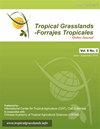墨西哥东北部几种多用途灌木叶片的季节营养价值及体外发酵动力学
IF 0.7
4区 农林科学
Q3 AGRICULTURE, DAIRY & ANIMAL SCIENCE
引用次数: 0
摘要
本研究旨在确定季节性化学成分、代谢能(ME)浓度、体外产气模式、,2018年7月至2019年6月,在墨西哥东北部的两个研究地点,生长在半干旱地区的5种本地灌木物种(苍白塞尔蒂斯、酸豆Croton suaveolens、狭叶番荔枝、狭叶愈创木和阿氏帕金森)的叶片的体外有机质消化率(IVOMD)和体外真有机质消化度(IVTOMD)。在叶片材料中发现的粗蛋白(CP)浓度(>13.2%DM)应满足或超过小型反刍动物的饲养要求;苍白念珠菌提供了最高的CP%(20.8-29.3%)。虽然CP%随季节和地点的变化而变化,但物种的影响比这两个因素都大。ME浓度在1.2至2.0 Mcal/kg DM之间。中性洗涤剂纤维和酸性洗涤剂纤维浓度分别在29.8%至51.7%DM和9.8至33.0%DM之间。IVOMD(34.5-58.8%)和IVTOMD(64.1-88.7%)获得的数据表明,所研究的浏览物种的叶子,特别是苍白念珠菌,作为墨西哥东北部半干旱地区小型反刍动物的有用饲料补充剂,具有很高的营养潜力。进一步的研究可以检验不同物种浏览的DM产量、小反刍动物的接受程度及其在放牧条件下定期落叶的可持续性。本文章由计算机程序翻译,如有差异,请以英文原文为准。
Seasonal nutritive value and in vitro fermentation kinetics of foliage of some multipurpose shrub species in northeastern Mexico
This study aimed to determine seasonal chemical composition, metabolizable energy (ME) concentration, in vitro gas production patterns, in vitro organic matter digestibility (IVOMD) and in vitro true organic matter digestibility (IVTOMD) of foliage from 5 native shrub species (Celtis pallida, Croton suaveolens, Forestiera angustifolia, Guaiacum angustifolium and Parkinsonia aculeata) growing in semi-arid areas of northeastern Mexico between July 2018 and June 2019 at 2 research sites. Crude protein (CP) concentrations (>13.2% DM) found in leaf material should meet or exceed the requirements for maintenance of small ruminants; C. pallida provided the highest CP% (20.8‒29.3%). While CP% varied with season and site, species had a greater effect than either of those factors overall. ME concentrations ranged between 1.2 and 2.0 Mcal/kg DM. Neutral detergent fiber and acid detergent fiber concentrations ranged from 29.8 to 51.7% DM and 9.8 to 33.0% DM, respectively. Data obtained for IVOMD (34.5‒58.8%) and IVTOMD (64.1‒88.7%) demonstrate the high nutritive potential of leaf of browse species under study, especially C. pallida, as useful feed supplements for small ruminants in the semi-arid region of northeastern Mexico. Further studies could examine DM yields of browse from the various species, acceptance by small ruminants and their sustainability under regular defoliation under grazing.
求助全文
通过发布文献求助,成功后即可免费获取论文全文。
去求助
来源期刊

Tropical Grasslands-Forrajes Tropicales
Agricultural and Biological Sciences-Agronomy and Crop Science
CiteScore
1.60
自引率
0.00%
发文量
36
审稿时长
16 weeks
期刊介绍:
The Journal publishes, in English or Spanish, Research Papers and Short Communications on research and development, as well as contributions from practitioners (Farmer Contributions) and Review Articles, related to pastures and forages in the tropics and subtropics. There is no regional focus; the information published should be of interest to a wide readership, encomprising researchers, academics, students, technicians, development workers and farmers.
In general, the focus of the Journal is more on sown (''improved'') pastures and forages than on rangeland-specific aspects of natural grasslands, but exceptions are possible (e.g. when a submission is relevant for a particularly broad readership in the pasture and forage science community).
The Journal will also consider the occasional publication of associated, but closely related, research in the form of an additional scientific communication platform [e.g. a re-make of the former Genetic Resources Communication series of the former Division of Tropical Crops and Pastures of the Commonwealth Scientific and Industrial Research Organisation (CSIRO), Australia].
Areas of particular interest to the Journal are:
Forage Genetic Resources and Livestock Production[...]
Environmental Functions of Forages[...]
Socio-economic Aspects[...]
Topics within the aforementioned areas may include: Diversity evaluation; Agronomy; Establishment (including fertilization); Management and utilization; Animal production; Nutritive value; Biotic stresses (pests and diseases, weeds); Abiotic stresses (soil fertility, water, temperature); Genetics and breeding; Biogeography and germplasm collections; Seed production; Ecology; Physiology; Rhizobiology (including BNF, BNI, mycorrhizae); Forage conservation; Economics; Multilocational experimentation; Modelling.
 求助内容:
求助内容: 应助结果提醒方式:
应助结果提醒方式:


